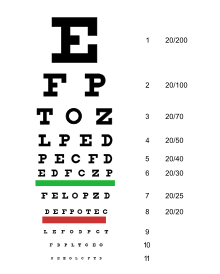From Wikipedia, the free encyclopedia
A LogMAR chart or Bailey-Lovie chart [1] or ETDRS chart (Early Treatment Diabetic Retinopathy Study) [2] comprises rows of letters and is used by ophthalmologists, optometrists and vision scientists to estimate visual acuity. This chart was developed at the National Vision Research Institute of Australia in 1976, and is designed to enable a more accurate estimate of acuity than do other charts (e.g., the Snellen chart).[3] For this reason, the LogMAR chart is recommended, particularly in a research setting.[4]
When using the LogMAR chart, visual acuity is scored with reference to the Logarithm of the Minimum Angle of Resolution, as the chart’s name suggests. An observer who can resolve details as small as 1 minute of visual angle scores LogMAR 0, since the base-10 logarithm of 1 is 0; an observer who can resolve details as small as 2 minutes of visual angle (i.e., reduced acuity) scores LogMAR 0.3, since the base-10 logarithm of 2 is near-approximately 0.3; and so on.
History
The chart was designed by Ian Bailey and Jan E Lovie-Kitchin at the National Vision Research Institute of Australia.[3][1] They described their motivation for designing the LogMAR chart as follows: “We have designed a series of near vision charts in which the typeface, size progression, size range, number of words per row and spacings were chosen in an endeavour to achieve a standardization of the test task.”
Relation to the Snellen chart
The Snellen chart, which dates back to 1862, is also commonly used to estimate visual acuity. A Snellen score of 6/6 (20/20), indicating that an observer can resolve details as small as 1 minute of visual angle, corresponds to a LogMAR of 0 (since the base-10 logarithm of 1 is 0); a Snellen score of 6/12 (20/40), indicating an observer can resolve details as small as 2 minutes of visual angle, corresponds to a LogMAR of 0.3 (since the base-10 logarithm of 2 is near-approximately 0.3), and so on.
Recording visual acuity using the LogMAR chart
| Foot | Metre | Decimal | LogMAR |
|---|---|---|---|
| 20/200 | 6/60 | 0.10 | 1.00 |
| 20/160 | 6/48 | 0.125 | 0.90 |
| 20/125 | 6/38 | 0.16 | 0.80 |
| 20/100 | 6/30 | 0.20 | 0.70 |
| 20/80 | 6/24 | 0.25 | 0.60 |
| 20/63 | 6/19 | 0.32 | 0.50 |
| 20/50 | 6/15 | 0.40 | 0.40 |
| 20/40 | 6/12 | 0.50 | 0.30 |
| 20/32 | 6/9.5 | 0.63 | 0.20 |
| 20/25 | 6/7.5 | 0.80 | 0.10 |
| 20/20 | 6/6 | 1.00 | 0.00 |
| 20/16 | 6/4.8 | 1.25 | −0.10 |
| 20/12.5 | 6/3.8 | 1.60 | −0.20 |
| 20/10 | 6/3 | 2.00 | −0.30 |
Each letter has a score value of 0.02 log units. Since there are 5 letters per line, the total score for a line on the LogMAR chart represents a change of 0.1 log units.[5] The formula used in calculating the score is:
- LogMAR VA = 0.1 + LogMAR value of the best line read – 0.02 X (number of optotypes read)
Given that each line has 5 optotypes, the equivalent formula is:
- LogMAR VA = LogMAR value of the best line read + 0.02 X (number of optotypes missed)
Some digital eye charts like Visual Acuity Charts can calculate the score.
Advantages of LogMAR over other charts
The LogMAR chart is designed to enable more accurate estimates of acuity as compared to other acuity charts (e.g., the Snellen chart).[3] Each line of the LogMAR chart comprises the same number of test letters (effectively standardizing the test across letter size); the Sloan font is used (Sloan letters are approximately equally legible one from another); letter size from line to line varies logarithmically, as does the spacing between lines (making the chart easy to use at nonstandard viewing distances).
Zero LogMAR indicates standard vision, positive values indicates poor vision, and negative values indicates good visions. This is less intuitive than other VA notations. However, LogMAR is actually a notation of vision loss.
Low vision and blindness definition with LogMAR
The World Health Organization established criteria for low vision using the LogMAR scale. Low vision is defined as a best-corrected visual acuity worse than 0.5 LogMAR but equal or better than 1.3 LogMAR in the better eye.[6][needs update] Blindness is defined as a best-corrected visual acuity worse than 1.3 LogMAR.[6]
References
- ^ Jump up to:a b “First Research starts in 1974”. National Vision Research Institute. Retrieved 2015-09-24.
- ^ Bailey IL, Lovie JE (2013). Visual acuity testing. From the laboratory to the clinic. Vision Research 90: 2-9. doi:10.1016/j.visres.2013.05.004.
- ^ Jump up to:a b c Bailey IL, Lovie JE. I (1976.) New design principles for visual acuity letter charts. Am J Optom Physiol Opt. 53 (11): pp. 740–745.
- ^ Grosvenor, Theodore (2007). Primary care Optometry. St. Louis, Missouri: ELSEVIER. pp. 174–175. ISBN 9780750675758.
- ^ Carlson, Kurts, Nancy, Daniel (2004). Clinical Procedures of Ocular Examination. U.S.A: McGraw HIll. p. 10. ISBN 978-0-07-137078-3.
- ^ Jump up to:a b Virgili G, Acosta R, Grover LL, Bentley SA, Giacomelli G (2013). “Reading aids for adults with low vision”. Cochrane Database Syst Rev. 10 (10): CD003303. doi:10.1002/14651858.CD003303.pub3. PMC 4288929. PMID 24154864.

